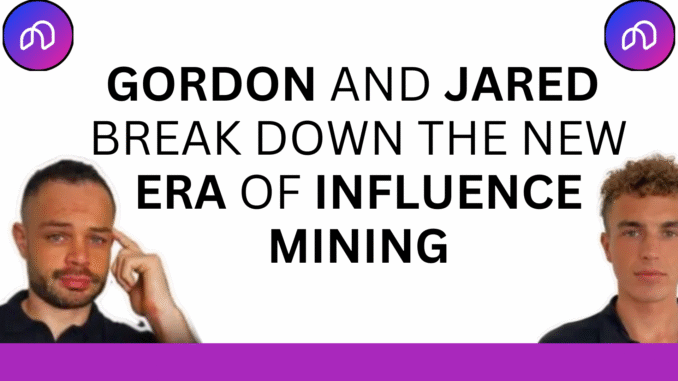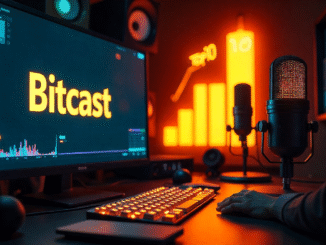
The launch of Bitcast’s mining system on X (formerly Twitter) marks one of the biggest steps yet for attention-based mining in the Bittensor ecosystem.
What began as a simple YouTube mining experiment has now evolved into a fully on-chain influence economy, and in a recent conversation, Gordon Frayne and Jared Lawrence unpacked exactly what this shift means.
Their back and forth offered one of the clearest explanations yet of how Bitcast works, why it matters, and what this rollout could become for creators and brands alike.
A Natural Evolution: From YouTube Mining to X Mining
Gordon set the stage right away. He has been mining on Bitcast through YouTube for months, so seeing the new X rollout firsthand gave him a practical lens to compare the two.
He opened with a simple question that many newcomers share: “If someone has never touched Bitcast before, what does mining on X even mean?”
Jared jumped in immediately, smoothing out the confusion with his signature clarity.
“Mining on Bitcast literally means creating content. That’s it. Out of the whole Bittensor ecosystem, it’s the easiest form of mining.”
It requires no servers, no hardware, and no technical setup. You simply create content, post it, and earn based on how well it performs.
And with the launch of X mining, the reach expands dramatically. Users can now mine directly through their regular X activity, transforming everyday engagement into something that earns real TAO.
How Bitcast Chooses Its Miners: The Top 150
But not everyone becomes a miner by default. Bitcast runs a ranking system that analyzes influence inside the Bittensor conversation.
Gordon explained that the system is surprisingly sophisticated, “They’re tracking almost 400 accounts right now. And from that list, the top 150 thought leaders qualify to mine.”
These aren’t random accounts. They’re builders, analysts, creators, researchers, subnet operators; basically, anyone consistently shaping the public conversation around Bittensor.
The ranking updates every week, and as you gain influence, you move in while losing influence pushes you out, creating a dynamic and merit-based influence economy.
Jared loved the simplicity of the idea. He commented, “You’re rewarded for real engagement, not vanity numbers. And businesses can now use Bitcast to connect directly with creators without the middlemen.”
It’s noteworthy to say that Bitcast is turning X into an influence marketplace.
The First Bitcast X Brief (Campaign): Score Takes the Spotlight
This brings us to the first official brief launched by Bitcast X on Score (Subnet 44)
Bitcast allocated a $1,000 reward pool, and eligible miners could participate by creating posts related to Score. The results were ranked based on engagement from other top ‘thought leaders’, not random accounts.
Gordon summarized it neatly, “It’s not about impressions. It’s about influence within the Bittensor brain.”
Top contributors included familiar names like Siam Kidd, Mark Jeffrey, Evert Scott and many rising creators in the TAO community
It was a clean first run, and the mechanism operated smoothly for a debut experiment.
Early Friction and Real Feedback
But both speakers acknowledged that early iterations never come without friction.
Some creators felt unsure about posting brief content they didn’t fully align with. Others wondered whether influence scores would eventually expand beyond the Bittensor bubble.
Jared addressed this honestly, he said, “It’s a new business model. We start, gather feedback, refine, and move forward. That’s how every subnet evolves.”
Gordon backed this up with experience from the YouTube rollout. The first few weeks of Bitcast mining required constant tweaks to prevent gaming and make scoring fair.
The X rollout will follow the same path: early experimentation, iteration, refinement, and continuous learning.
Influence Mining as Strategy: The Attention Arbitrage Angle
Toward the end of the conversation, Jared shifted gears from analysis to strategy.
He pointed out that the next brief will revolve around Vidaio (Subnet 85), a project he considers both undervalued and underrated.
“More attention on a subnet always gives you something to think about. Is there a way to position before people start posting?”
It was a smart observation. Influence mining isn’t only about earning $TAO.
It also moves capital, shifts narratives, and signals where attention is about to flow next.
In an ecosystem where attention often precedes price movement, Bitcast briefly becomes an early signal generator.
Why Bitcast Matters More Than Most Realize
Both speakers converged on a shared belief: Bitcast is solving a real problem.
On social platforms like X, where the system can be gamed (Influence can be faked, engagement can be bought, and bot networks distort visibility), Bitcast flips the script by rewarding earned credibility within a real community.
For Bittensor, it showcases a new frontier of decentralized reputation.
Bitcast isn’t just a subnet; it’s a blueprint for a trust-based attention economy.
Final Thoughts: A New Chapter in the Influence Economy
From X mining to rotating influence scores to transparent reward distribution, Bitcast is redefining how creators, communities, and brands interact online.
Gordon closed the discussion with optimism, noting that the rollout has been smooth for a first experiment and that the next few weeks will reveal how scalable this new model truly is.
Jared echoed that feeling but added one final thought he submitted, “It’s only just beginning. The more briefs they launch, the more powerful this system becomes.”
Bitcast X isn’t just a feature update; it’s the start of a broader economic shift inside Bittensor, one where influence is measurable, rewardable, and finally, transparent.
Access Bitcast
Official Website: https://bitcast.network/
X (Formerly Twitter): https://x.com/bitcast_network




Be the first to comment